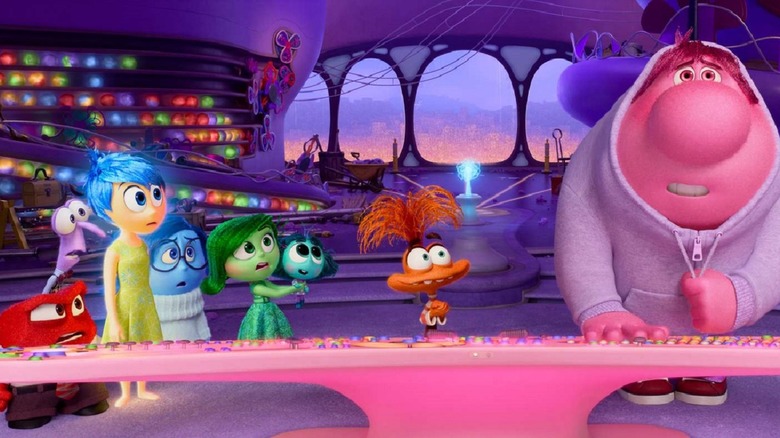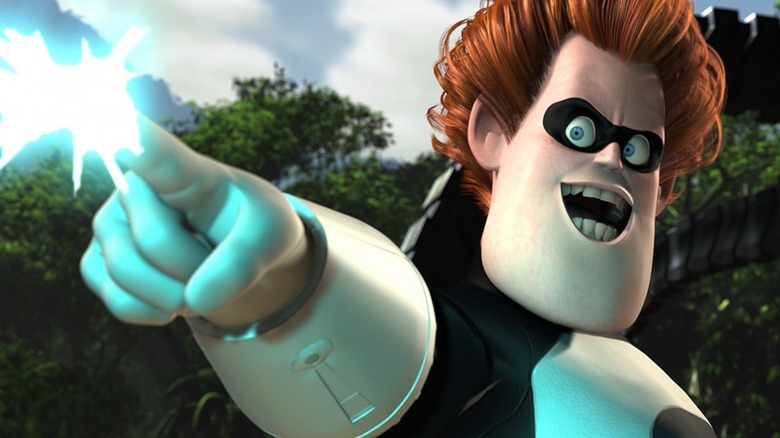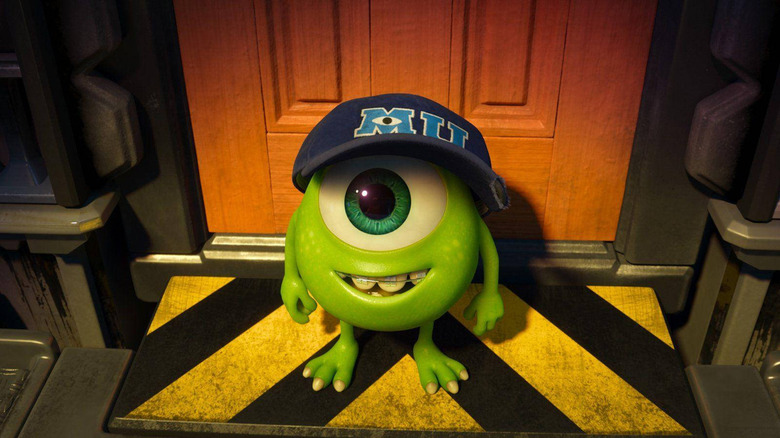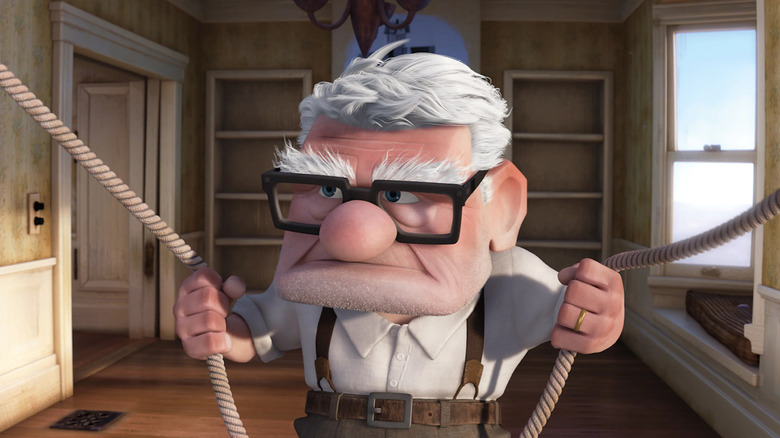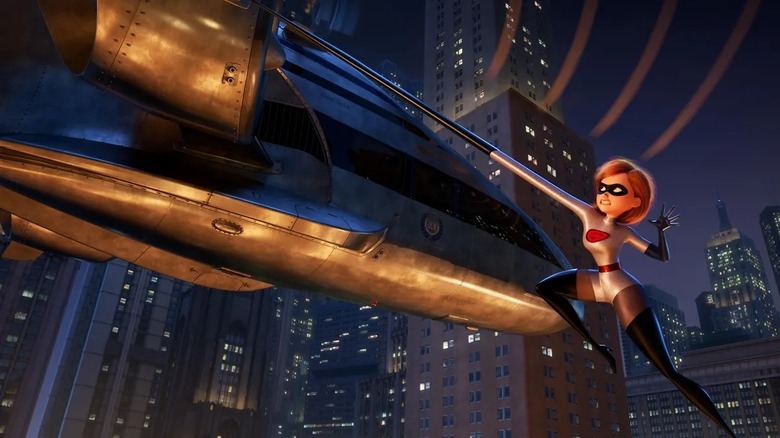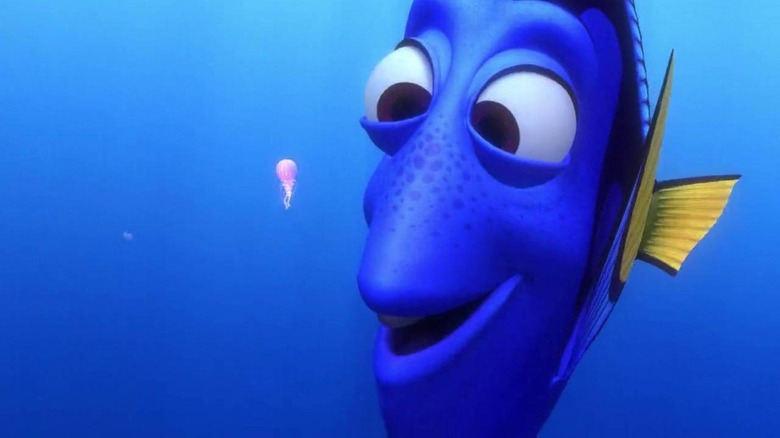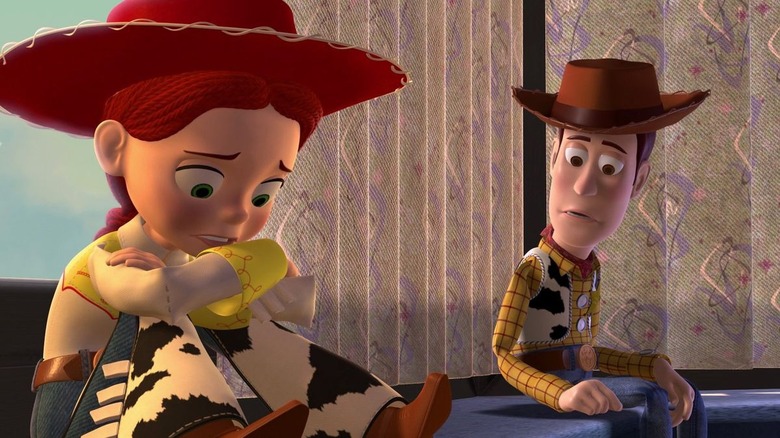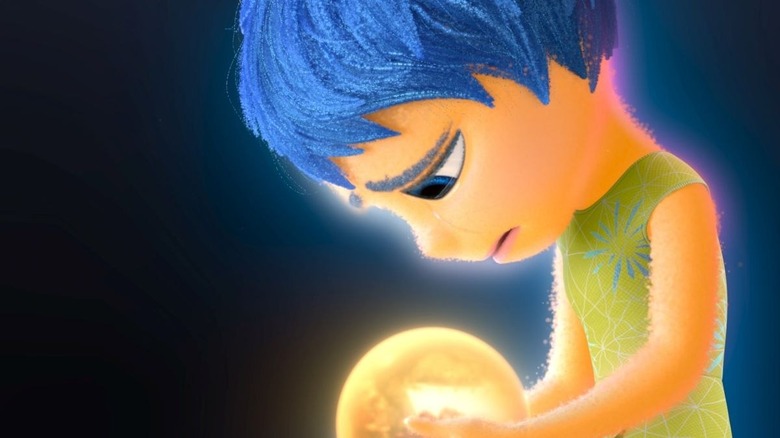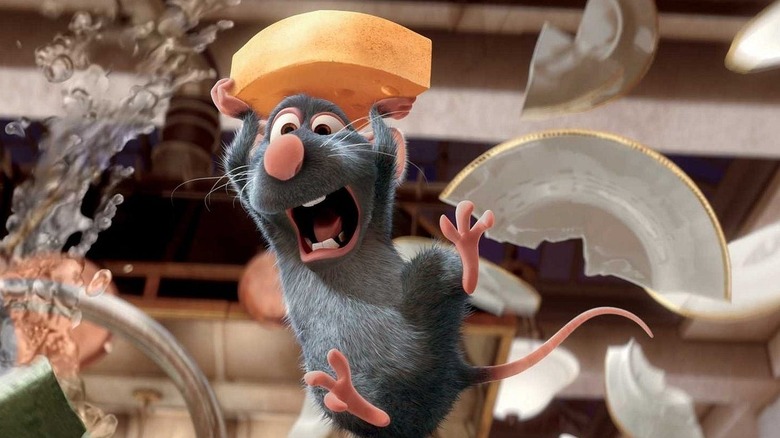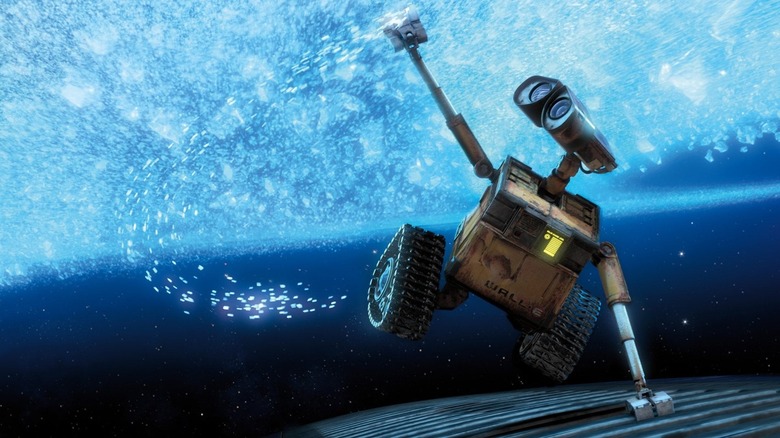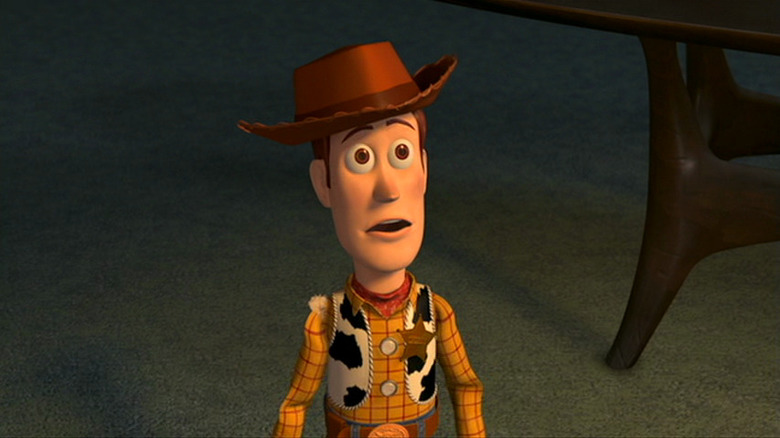The 10 Best Pixar Characters, Ranked
Pixar Animation Studios has been something of an industry standard-bearer for nearly three decades. In the fall of 1995, they not only proved that computer animation could be utilized to tell a full feature-length story with "Toy Story," but they also proved that there were different types of stories that could be told in all-ages animation, introducing us to the worlds of toys, monsters, talking cars, superheroes, and more. This summer marks the return of yet another of their beloved original films, as the 2015 classic "Inside Out" gets a sequel in the form of "Inside Out 2."
The marketing for "Inside Out 2" has leaned heavy on one thing: new characters. In the first film, we met the five core emotions driving the mind of young Riley as she moved with her family from Minnesota to San Francisco. Now that she's ensconced in the Bay Area, Riley has all-new emotions, which means there are a bevy of new characters for audiences to meet. But are any of them among the 10 best characters that Pixar has introduced us to in nearly 30 years of filmmaking? Let's find out.
10. Syndrome, The Incredibles
Funny thing about Pixar: They don't have a lot of memorable villains. This is partially by design, in that the films so often focus on the mismatched buddies at the center that antagonists don't always make an impact. In "The Incredibles," though, the bad guy has a fascinating journey of his own and has to stand apart. It is a superhero film, after all, and a hero is only as memorable as his villainous counterpart. As voiced by Jason Lee, Syndrome is full of frustration and cynicism, and plenty of dangerous intelligence. Syndrome was once a superfan of Mr. Incredible, before the true superhero pushed away a childish pretender who did have quite the eye for scientific gadgets. Years later, that kid has morphed into Syndrome, using those same powerful gadgets to attempt to establish himself as a new kind of hero ... by killing off actual superheroes.
Syndrome is a truly dangerous character not just because he's smart enough to build big gadgets, but because he's smart enough to know how superheroes work. "You sly dog ... you got me monologuing!" is one of the great underrated lines in a Pixar film because it belies a knowledge that its writer/director Brad Bird has and is aware the audience has, too. It's not just one-liners like that which help Syndrome stand out. His entire plan, to enable anyone to utilize his gadgets and "become" super, is meant as a grim reminder that by not exalting the truly special, notable gifts can get ignored. Syndrome's as shocking as his orange hair, in some ways, a memorable villain who partially stands out because of how few notable bad guys Pixar has.
9. Mike Wazowski, Monsters, Inc. and Monsters University
One of the more underrated character arcs in a Pixar film comes courtesy of the 2013 prequel "Monsters University," which focuses more on the one-eyed Mike Wazowski (Billy Crystal) than on his big, hairy counterpart James P. Sullivan (John Goodman). Part of the film's setup is a pretty easy softball: what if these two best friends had first met and couldn't stand each other? But the beginning of the movie sets up a more fascinating creative challenge. From the raucous 2001 comedy "Monsters, Inc.", we know that Sulley is the scary one of this duo, and that Mike's power comes from making those around him laugh. But the younger Mike wants badly to be a Scarer like all his heroes, even though we know innately that he's not really that scary.
It's true that "Monsters, Inc." is a better overall film than "Monsters University," but the latter film does an excellent job of fleshing out the wacky and talkative Mike, giving him depth that didn't previously exist in the 2001 film and making that experience just a bit richer when you watch them in chronological order. That Billy Crystal can bring a chatterbox to hilarious life isn't surprising, and Mike is as fierce a friend as many other Pixar stalwarts. But "Monsters University" gave Mike unseen dimension and helped him become a lot more compelling than his hairy pal.
8. Carl Fredricksen, Up
Just over 15 years later, there are still very few scenes in the Pixar canon that hit quite as hard as the "Married Life" sequence at the start of the 2009 adventure "Up." The conventional wisdom about the film as a whole is that it can't quite top the emotional devastation wrought in that brief sequence set to Michael Giacchino's Oscar-winning score, as we watch Carl Fredricksen and his wife Ellie grow up together, falling in love, getting married, trying and failing to have children of their own, getting old, and eventually passing away. Well, Ellie dies, though some part of Carl seems to as well. But the entirety of "Up," relying on the taciturn and much older Carl (voiced by the incomparable Ed Asner), works precisely because of the gruff Carl and how he gradually softens over time and is able to move on from his wife's passing.
"I'm going to Paradise Falls if it kills me!" Carl shouts at one fraught moment, and it's a disturbing reminder of how much is truly at stake for the character. Even within the framing of this adventure occurring because an old man lifts his house up via balloons, there's a dark undercurrent to Carl as a person because of how much of his life is uniquely tied to Ellie. As instantly sad as the "Married Life" sequence is, the film after that sequence packs a slower-motion gut-punch as we grasp exactly how much grief Carl is experiencing at the end of his life. "Up" features an excellent opening sequence, it's true; it also has one of the studio's best, most well-rounded characters.
7. Elastigirl/Helen Parr, The Incredibles and Incredibles II
Helen Parr, AKA Elastigirl, is one of the most complicated characters in Pixar's history. Voiced by Holly Hunter, Elastigirl is first depicted as one of the most gifted superheroes around who seems very comfortable only ever living the super life. "Leave the saving of the world to the men? I don't think so! ... I don't think so" is one of her first lines of dialogue, and yet the way it trails off hints at the character's multi-dimensional nature. For much of the first half of "The Incredibles," Helen Parr is very comfortable living her alter-ego life, and tries very badly to ensure that the rest of her supernaturally gifted family acts similarly normal and boring. It's easy to watch the film and see Helen as a killjoy, but she is arguably one of the more mature characters in Pixar's canon, let alone within the film itself.
You can perceive a commentary that being a mother is being a true superhero as pat and trite, but the way writer/director Brad Bird brings this idea to three-dimensional life means that we see Helen's superpowered stretching ability come into play less as a cool and show-offy way to impress her kids and more as a way to literally save them from death. (With time, the film's most chilling scene is the one in which Helen desperately tries to convince Syndrome's goons from shooting down their plane because "there are children onboard!") Hunter had long since proven herself to be one of the best actresses of her generation, but her work as the complex Elastigirl helps the character become truly unforgettable.
6. Dory, Finding Nemo and Finding Dory
Hard as it may be to believe, Ellen DeGeneres' second-stage career as a talk-show host didn't get off the ground until after the release of "Finding Nemo" in 2003. It helped that her talk show started the following fall, and that people had quickly and quite understandably fallen in love with the forgetful Blue Tang called Dory. "Finding Nemo" is another big adventure with mismatched characters paired together, but unlike previous Pixar efforts, one of the pair is blissfully unaware of how much they bother their other half. That's because Dory has short-term memory loss, which is a twist so ridiculous that it manages to work extremely effectively.
Of course, the other reason why Dory works so well is because of DeGeneres' performance and how it felt a little inspired by her specific delivery on stage as a stand-up comic. Dory is a brilliant foil for the neurotic and intelligent Marlin, blithely swimming through her forgetful life with few cares in the world; moreover, when the character realizes how much this specific journey has enabled her memory to improve just a little bit, Dory's impassioned monologue at the end of "Nemo" becomes very emotionally effective indeed. The 2016 follow-up "Finding Dory" put the Blue Tang in the spotlight, allowing us to meet the rest of her family, but really, it was "Finding Nemo" that made Dory one of the most memorably beloved characters in the Pixar filmography.
5. Jessie the Yodeling Cowgirl, Toy Story 2, Toy Story 3, and Toy Story 4
When you think about the casting efforts that go into Pixar films, it's easy to wonder how much the producers there adore the James L. Brooks film "Broadcast News." That 1987 comedy-drama co-starred Holly Hunter, Albert Brooks, and Joan Cusack, who not only went on to voice some of Pixar's characters, but they managed to separately bring to life three of the studio's best characters. (Brooks' Marlin may not be on this list, but consider him at the top of the Honorable Mentions list.) Cusack was the first major addition to the "Toy Story" franchise with her arrival in the 1999 sequel "Toy Story 2," portraying Jessie the Yodeling Cowgirl, the female counterpart of Sheriff Woody on a 1950s-era TV show that introduced the fictional world to our cowboy hero.
But Jessie's life as a toy is far less charmed when Woody meets her. She's ready to be boxed up and shipped off to Japan to be part of a "Woody's Roundup" exhibit at a toy museum, because she was once abandoned by her own child and it's haunted her for years. It helps that Jessie's emotional backstory is revealed in the Patient Zero of Pixar tearjerkers, with Sarah MacLachlan singing "When She Loved Me" over the soundtrack. That aside, Cusack's performance goes well beyond replacing her natural Chicago accent for a Southern twang. She brings sadness and resentment and hesitancy and joy to Jessie, creating a character full of pathos and life far beyond what the animators were able to visualize.
4. Joy, Inside Out and Inside Out 2
You can look at Joy in both "Inside Out" and "Inside Out 2" and see the motherly side of Pixar coming out. Where films such as "Finding Nemo" or even "Monsters, Inc." are essentially about fathers (or father figures) coming to terms with their children growing up and moving beyond them, the "Inside Out" films are more focused on the female psyche. Though the five emotions inside the head of young Riley include male voices (Lewis Black as the fiery Anger, and the shaky Fear being voiced in the first film by Bill Hader and now by Tony Hale), Riley herself is guided by Joy (Amy Poehler), as well as Sadness (Phyllis Smith) and now new emotions like Anxiety (Maya Hawke).
What makes Joy so lovable is less her innate and effervescent positivity, and more about how she handles distressing moments. Near the end of "Inside Out," before Joy returns to Riley's Headquarters, she presumes she's stuck in the Memory Dump forever and has an emotional breakdown brought brilliantly to life both by Poehler and the filmmakers, holding on a long close-up of Joy for 30 seconds (which feels like an eternity in fast-paced mainstream animation).
[Note: Very light spoilers for "Inside Out 2" ahead.]
And in "Inside Out 2," Joy and her fellow emotions are cast out by Anxiety in the name of helping Riley become her better self, and Joy has to admit that her constantly upbeat nature can be a drain on others and herself. That Joy is so open about her flaws in such dark moments only makes her more relatable and winning.
3. Remy, Ratatouille
Brad Bird has a habit of crafting characters who are a little less cuddly both on the outside and on the inside. The heroes of "The Incredibles" are filled with understandable turmoil, but even they are a lot more charming than ... well, a rat. Few Pixar films have taken more risks with audience favor than the superlative "Ratatouille," because it asks us to sympathize with a rat who wants to cook in the fanciest kitchens in Paris. As voiced by the whip-smart comedian and actor Patton Oswalt, Remy is one of the thorniest characters in Pixar history. As strange as his background is, Remy is an uncompromising artist who refuses to accept the limitations imposed upon him by the world simply because he was born as a rat.
Many of the characters in "Ratatouille" are similarly tough and uncompromising, from the fierce and terrifying food critic Anton Ego (Peter O'Toole) or the lovely and intelligent Colette (Janeane Garofalo). But Remy is the toughest of all, believing to the bottom of his core the famous credo that "anyone can cook". Fortunately for Remy, he's as right that not anyone should cook as he is that he has the gift of haute cuisine in his furry little bones. Remy is a singular Pixar character, one whose goal is all about his specific needs, even if those needs take him away from his home life or push him away from his supporters. He's an artist, and the character is one of Pixar's best creations. (It's no wonder the late Anthony Bourdain once called "Ratatouille" the best food movie ever made.)
2. WALL-E, WALL-E
The 2008 film "WALL-E" is still the most technically and creatively ambitious film Pixar has ever made, in no small part because the filmmakers gave themselves a seemingly insurmountable challenge. Could they tell an effective story with characters who don't talk and aren't human, in a story set hundreds of years in the future in the midst of a destroyed planet Earth? Although WALL-E is not human, the boxy little garbage-collecting robot is one of the most humane characters Pixar has ever created. As envisioned by co-writer and director Andrew Stanton, WALL-E is a robot whose initial protocol–to clean up Earth after humans trashed it for centuries gets superseded by an unexpected and innate curiosity the robot has about random bric-a-brac and doodads, as well as an intense passion to fall in love.
WALL-E manages to meet and help save the rest of the human race before his adventure, and also fall in love with Eve, a much sleeker and more up-to-date robot whose own mission dovetails with WALL-E's discovery of plant life on Earth. In the 15-plus years since the release of "WALL-E," Pixar has made other romances and plenty of stories with similarly high-concept and daring premises. But "WALL-E" remains one of the company's finest efforts in large part because the chattering robot (with sound effects provided by the legendary Ben Burtt) is so instantly charming and cuddly.
1. Sheriff Woody, Toy Story, Toy Story 2, Toy Story 3, and Toy Story 4
Sheriff Woody is arguably the template for all of the best and most memorable Pixar characters (as well as a few of the more forgettable ones). It helps that the old-fashioned cowboy doll, so beloved by owners like Andy and Bonnie, is voiced by Tom Hanks in one of his finest and most enduring performances. Woody is, like a number of other Pixar protagonists, something of his own worst enemy. Just as Marlin's neuroses are what lead him to lose his son Nemo, or Remy's arrogance is what pushes him away from friends and family, and so on, Woody is both a relatable hero and a character whose sometimes-unavoidably selfish nature makes him pricklier than the average good guy.
But at his heart, Woody isn't just a boy's best friend — he's as dedicated a friend as his fellow toys could ask for. It doesn't take long for him to take a dislike to the shiny new space toy Buzz Lightyear in the original "Toy Story," but he's quickly won over by Buzz as they embark on an adventure to escape the clutches of a destructive older child and get back to Andy's bedroom. And while follow-up films in the series offer echoes of what comes in the original, Woody's complexity stands out and above his fellow toys. It's Woody who has to grapple with the disturbing notion of not being played with, far more than Buzz does in either "Toy Story 2" or "Toy Story 3," and it's Woody who finally makes peace with that notion at the end of "Toy Story 4," bidding adieu to his friends and riding off with his true love, Bo Peep. Even with the impending arrival of a fifth film and a potentially new character arc, Woody reigns supreme among all of Pixar characters.
